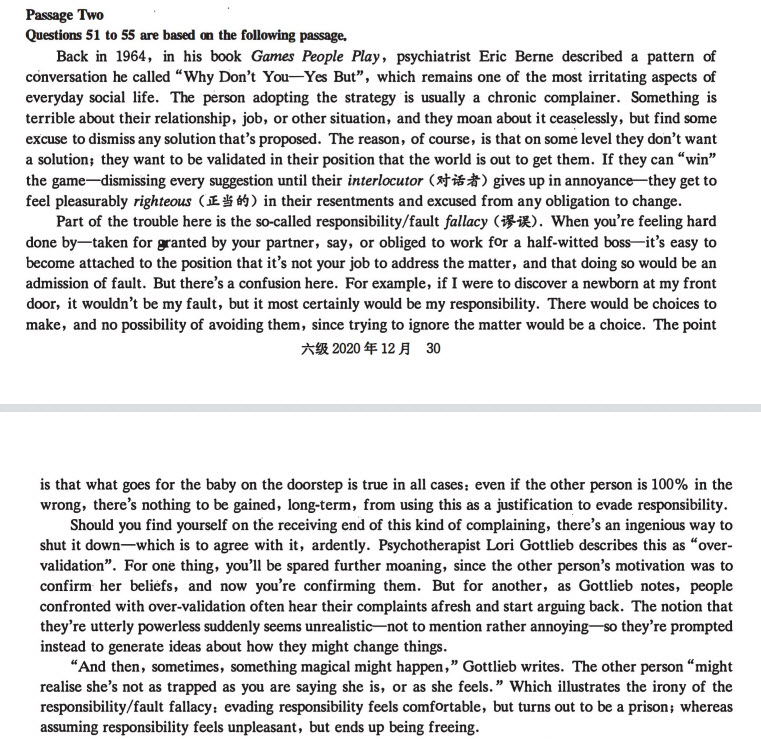

51.C
52.D
53.A
54.B
55.C


灯笼起源于东汉, 最初主要用于照明。在唐代,人们用红灯笼来庆祝安定的生活。从那时起,灯笼在中国的许多地方流行起来。灯笼通常用色彩鲜艳的薄纸制作,形状和尺寸各异。在中国传统文化中,红灯笼象征生活美满和生意兴隆,通常在春节、元宵节和国庆等节日期间悬挂。如今,世界上许多其他地方也能看到红灯笼。
People have grown taller over the last century, with South Korean women shooting up by more than 20cm on average, and Iranian men gaining 16.5cm. A global study looked at the average height of 18-year-olds in 200 countries between 1914 and 2014.
The results reveal that while Swedes were the tallest people in the world in 1914, Dutch men have risen from 12th place to claim top spot with an average height of 182.5cm. Latvian women, meanwhile, rose from 28th place in 1914 to become the tallest in the world a century later, with an average height of 169.8cm.
James Bentham, a co-author of the research from Imperial College, London, says the global trend is likely to be due primarily to improvements in nutrition and healthcare. "An individual's genetics has a big influence on their height, but once you average over whole populations, genetics plays e less key role," he added.
A little extra height brings a number of advantages, says Elio Riboli of Imperial College. "Being taller is associated with longer life expectancy," he said. "This is largely due to a lower risk of dying of cardiovascular (心血管的)disease among taller people."
But while height has increased around the world, the trend in many countries of north and sub-Saharan Africa causes concern, says Riboli. While height increased in Uganda and Niger during the early 20th century, the trend has reversed in recent years, with height decreasing among 18-year-olds.
"One reason for these decreases in height is the economic situation in the 1980s," said Alexander Moradi of the University of Sussex. The nutritional and health crises that followed the policy of structural adjustment, he says, led to many children and teenagers failing to reach their full potential in terms of height.
Bentham believes the global trend of increasing height has important implications. "How tall we are now is strongly influenced by the environment we grew u
According to the majority of Americans, women are every bit as capable of being good political leaders as men. The same can be said of their ability to dominate the corporate boardroom. And according to a new Pew Research Center survey on women and leadership, most Americans find women indistinguishable from men on key leadership traits such as intelligence and capacity for innovation, with many saying they're stronger than men in terms of being passionate and organized leaders.
So why, then, are women in short supply at the top of government and business in the United States? According to the public, at least, it's not that they lack toughness, management talent or proper skill sets.
It’s also not all about work-life balance. Although economic research and previous survey findings have shown that career interruptions related to motherhood may make it harder for women to advance in their careers and compete for top executive jobs, relatively few adults in the recent survey point to this as a key barrier for women seeking leadership roles. Only about one-in-five say women's family responsibilities are a major reason why there aren't more females in top leadership positions in business and politics.
Instead, topping the list of reasons, about four-in-ten Americans point to a double standard for women seeking to climb to the highest levels of either politics or business, where they have to do more than their male counterparts to prove themselves. Similar shares say the electorate (选民)and corporate America are just not ready to put more women in top leadership positions.
As a result, the public is divided about whether the imbalance in corporate America will change in the foreseeable future, even though women have made major advances in the workplace. While 53% believe men will continue to hold more top executive positions in business in the future, 44% say it's only a matter of time before as many women are in top executiv
A)Broad demographic (人口的)shifts in marital status, educational attainment and employment have transformed the way young adults in the U. S. are living, and a new Pew Research Center analysis highlights the implications of these changes for the most basic element of their lives -- where they call home. In 2014, for the first time in more than 130 years, adults ages 18 to 34 were slightly more likely to be living in their parents' home than they were to be living with a spouse or partner in their own household.
B)This turn of events is fueled primarily by the dramatic drop in the share of young Americans who are choosing to settle down romantically before age 35. Dating back to 1880, the most common living arrangement among young adults has been living with a romantic partner, whether a spouse or a significant other. This type of arrangement peaked around I960, when 62% of the nation's 18- to 34-year-olds were living with a spouse or partner in their own household, and only one-in-five were living with their parents.
C)By 2014, 31.6% of young adults were living with a spouse or partner in their own household, below the share living in the home of their parent(s) (32.1%). Some 14% of young adults lived alone, were a single parent or lived with one or more roommates. The remaining 22% lived in the home of another family member (such as a grandparent, in-law or sibling), a non-relative, or in group quarters like college dormitories.
D)It's worth noting that the overall share of young adults living with their parents was not at a record high in 2014. This arrangement peaked around 1940, when about 35% of the nation's 18- to 34-year- olds lived with mom and/or dad (compared with 32% in 2014). What has changed, instead, is the relative share adopting different ways of living in early adulthood, with the decline of romantic coupling pushing living at home to the top of a much less uniform list of living arrangements.
E)Among young a
Just because they can't sing opera or ride a bicycle doesn't mean that animals don't have culture. There's no better example of this than killer whales. As one of the most __26__ predators (食肉动物), killer whales may not fit the __27__ of a cultured creature. However, these beasts of the sea do display a vast range of highly __28__ behaviors that appear to be driving their genetic development.
The word "culture" comes from the Latin "colere," which __29__ means "to cultivate." In other words, it refers to anything that is __30__ or learnt, rather than instinctive or natural. Among human populations, culture not only affects the way we live, but also writes itself into our genes, affecting who we are. For instance, having spent many generations hunting the fat marine mammals of the Arctic, the Eskimos of Greenland have developed certain genetic __31__ that help them digest and utilize this fat- rich diet, thereby allowing them to __32__ in their cold climate.
Like humans, killer whales have colonized a range of different __33__ across the globe, occupying every ocean basin on the planet with an empire that __34__ from pole to pole. As such, different populations of killer whales have had to learn different hunting techniques in order to gain the upper hand over their local prey (猎物). This, in turn, has a major effect on their diet, leading scientists to __35__ that the ability to learn population-specific hunting methods could be driving the animals, genetic development.
A) acquired
B) adaptations
C) brutal
D) deliberately
E) expressed
F) extends
G) habitats
H) humble
I) image
J) literally
K) refined
L) revolves
M) speculate
N) structure
O) thrive
For this part, you are allowed 30 minutes to write a news report to your campus newspaper on a visit to a Hope Elementary School organized by your Student Union. You should write at least 120 words but no more than 180 words.
剪纸是中国民间艺术的一种独特形式,已有2000多年历史。剪纸很可能源于汉代,继纸张发明之后。从此,它在中国的许多地方得到了普及。剪纸用的材料和工具很简单:纸和剪刀。剪纸作品通常是用红纸做成的,因为红色在中国传统文化中与幸福相联。因此,在婚礼、春节等喜庆场合,红颜色的剪纸是门窗装饰的首选。
Online programs to fight depression are already commercially available. While they sound efficient and cost-saving, a recent study reports that they are not effective, primarily because depressed patients are not likely to engage with them or stick with them.
The study looked at computer-assisted cognitive (认知的)behavioral therapy (CBT) and found that it was no more effective in treating depression than the usual care patients receive from a primary care doctor.
Traditional CBT is considered an effective form of talk therapy for depression, helping people challenge negative thoughts and change the way they think in order to change their mood and behaviors. However, online CBT programs have been gaining popularity, with the attraction of providing low-cost help wherever someone has access to a computer.
A team of researchers from the University of York conducted a randomized (随机的)control trial with 691 depressed patients from 83 physician practices across England. The patients were split into three groups: one group received only usual care from a physician while the other two groups received usual care I from a physician plus one of two computerized CBT programs. Participants were balanced across the three groups for age, sex, educational background' severity and duration of depression, and use of antidepressants (抗抑郁药).
After four months, the patients using the computerized CBT programs had no improvement in depression levels over the patients who were only getting usual care from their doctors.
"It's an important, cautionary note that we shouldn't get too carried away with the idea that a computer system can replace doctors and therapists," says Christopher Dowrick, a professor of primary medical care at the University of Liverpool. "We do still need the human touch or the human interaction, particularly when people are depressed. "
Being depressed can mean feeling "lost in your own small&#
Most kids grow up learning they cannot draw on the walls. But it might be time to unlearn that training-this summer, a group of culture addicts, artists and community organizers are inviting New Yorkers to write all over the walls of an old house on Governor's Island.
The project is called Writing On It All, and it's a participatory writing project and artistic experiment that has happened on Governor's Island every summer since 2013.
"Most of the participants are people who are just walking by or are on the island for other reasons, or they just kind of happen to be there," Alexandra Chasin, artistic director of Writing On It All, tells Smithsonian, com.
The 2016 season runs through June 26 and features sessions facilitated by everyone from dancers to domestic workers. Each session has a theme, and participants are given a variety of materials and prompts and asked to cover surfaces with their thoughts and art. This year, the programs range from one that turns the house into a collaborative essay to one that explores the meaning of exile.
Governor's Island is a national historic landmark district long used for military purposes. Now known as "New York's shared space for art and play," the island, which lies between Manhattan and Brooklyn in Upper New York Bay, is closed to cars but open to summer tourists who flock for festivals, picnics, adventures, as well as these "legal graffiti (涂鸦)" sessions.
The notes and art scribbled (涂画)on the walls are an experiment in self-expression. So far, participants have ranged in age from 2 to 85. Though Chasin says the focus of the work is on the activity of writing, rather than the text that ends up getting written, some of the work that comes out of the sessions has stuck with her.
"One of the sessions that moved me the most was state violence on black women and black girls," says Chasin, explaining that in one room, people wrote
A) We've always been a hands-on, do it-yourself kind of nation. Ben Franklin, one of America's founding fathers, didn't just invent the lightning rod. His creations include glasses, innovative stoves and more.
B) Franklin, who was largely self-taught, may have been a genius, but he wasn't really an exception when it comes to American making and creativity.
C) The personal computing revolution and philosophy of disruptive innovation of Silicon Valley grew, in part, out of the creations of the Homebrew Computer Club, which was founded in a garage in Menlo Park, California, in the mid-1970s. Members-including guys named Jobs and Wozniak-started making and inventing things they couldn't buy.
D) So it's no surprise that the Maker Movement today is thriving in communities and some schools across America. Making is available to ordinary people who aren't tied to big companies, big defense labs or research universities. The maker philosophy echoes old ideas advocated by John Dewey, Montessori, and even ancient Greek philosophers, as we pointed out recently.
E) These maker spaces are often outside of classrooms, and are serving an important educational function. The Maker Movement is rediscovering learning by doing, which is Dewey's phrase from 100 years ago. We are rediscovering Dewey and Montessori and a lot of the practices that they pioneered that have been forgotten or at least put aside. A maker space is a place which can be in a school, but it doesn't look like a classroom. It can be in a library. It can be out in the community. It has tools and materials. It's a place where you get to make things based on your interest and on what you, re learning to do.
F) Ideas about learning by doing have struggled to become mainstream educationally, despite being old concepts from Dewey and Montessori, Plato and Aristotle, and in the American context, Ralph Emerson, on the value of experience and self-relian